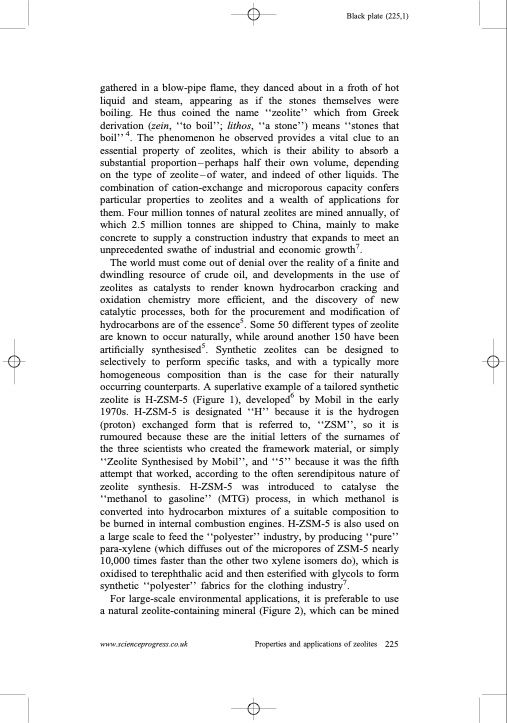
PDF Publication Title:
Text from PDF Page: 003
Black plate (225,1) gathered in a blow-pipe flame, they danced about in a froth of hot liquid and steam, appearing as if the stones themselves were boiling. He thus coined the name ‘‘zeolite’’ which from Greek derivation (zein, ‘‘to boil’’; lithos, ‘‘a stone’’) means ‘‘stones that boil’’4. The phenomenon he observed provides a vital clue to an essential property of zeolites, which is their ability to absorb a substantial proportion–perhaps half their own volume, depending on the type of zeolite–of water, and indeed of other liquids. The combination of cation-exchange and microporous capacity confers particular properties to zeolites and a wealth of applications for them. Four million tonnes of natural zeolites are mined annually, of which 2.5 million tonnes are shipped to China, mainly to make concrete to supply a construction industry that expands to meet an unprecedented swathe of industrial and economic growth7. The world must come out of denial over the reality of a finite and dwindling resource of crude oil, and developments in the use of zeolites as catalysts to render known hydrocarbon cracking and oxidation chemistry more efficient, and the discovery of new catalytic processes, both for the procurement and modification of hydrocarbons are of the essence5. Some 50 different types of zeolite are known to occur naturally, while around another 150 have been artificially synthesised5. Synthetic zeolites can be designed to selectively to perform specific tasks, and with a typically more homogeneous composition than is the case for their naturally occurring counterparts. A superlative example of a tailored synthetic zeolite is H-ZSM-5 (Figure 1), developed6 by Mobil in the early 1970s. H-ZSM-5 is designated ‘‘H’’ because it is the hydrogen (proton) exchanged form that is referred to, ‘‘ZSM’’, so it is rumoured because these are the initial letters of the surnames of the three scientists who created the framework material, or simply ‘‘Zeolite Synthesised by Mobil’’, and ‘‘5’’ because it was the fifth attempt that worked, according to the often serendipitous nature of zeolite synthesis. H-ZSM-5 was introduced to catalyse the ‘‘methanol to gasoline’’ (MTG) process, in which methanol is converted into hydrocarbon mixtures of a suitable composition to be burned in internal combustion engines. H-ZSM-5 is also used on a large scale to feed the ‘‘polyester’’ industry, by producing ‘‘pure’’ para-xylene (which diffuses out of the micropores of ZSM-5 nearly 10,000 times faster than the other two xylene isomers do), which is oxidised to terephthalic acid and then esterified with glycols to form synthetic ‘‘polyester’’ fabrics for the clothing industry7. For large-scale environmental applications, it is preferable to use a natural zeolite-containing mineral (Figure 2), which can be mined www.scienceprogress.co.uk Properties and applications of zeolites 225PDF Image | Properties and applications of zeolites

PDF Search Title:
Properties and applications of zeolitesOriginal File Name Searched:
003685010x12800828155007.pdfDIY PDF Search: Google It | Yahoo | Bing
CO2 Organic Rankine Cycle Experimenter Platform The supercritical CO2 phase change system is both a heat pump and organic rankine cycle which can be used for those purposes and as a supercritical extractor for advanced subcritical and supercritical extraction technology. Uses include producing nanoparticles, precious metal CO2 extraction, lithium battery recycling, and other applications... More Info
Heat Pumps CO2 ORC Heat Pump System Platform More Info
| CONTACT TEL: 608-238-6001 Email: greg@infinityturbine.com | RSS | AMP |